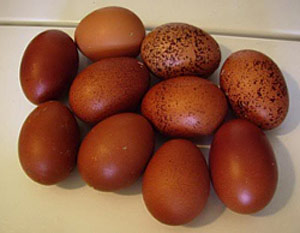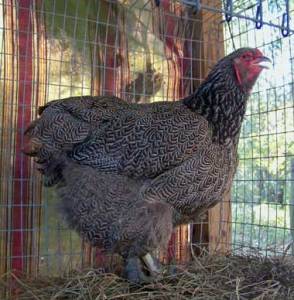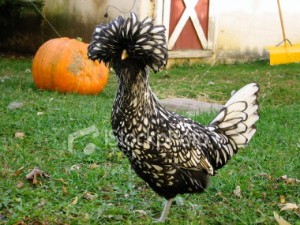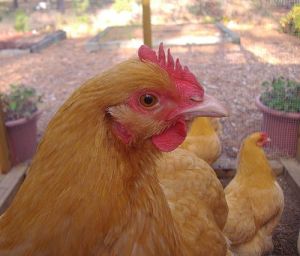The Welsummer was developed, in the Netherlands, and was named after the village of Welsum in Holland. The breed was created with the Partridge Cochin, Partridge Wyandotte, Partridge Leghorn, later in the 20th Century, the Barnevelder and Rhode Island Red were added. The American Poultry Association admitted the Welsummer into the American Standard of Excellence, in 1991.
QUALITIES and ATTRIBUTES
 Although the American Poultry Association only recognizes one variety, with a partridge pattern, breeders are working on creating other colors. Welsummers are a medium size bird, hens should be 6 pounds, and roosters 7 pounds. The beautiful, rich brown-red hued feathers and upright single comb make the Welsummer a striking chicken. Another interesting characteristic of the Welsummers, is the male/female feather color at hatching. This makes them (what is considered to be) an autosexing breed, although not as easily discernible as a Sex Link cross.
Although the American Poultry Association only recognizes one variety, with a partridge pattern, breeders are working on creating other colors. Welsummers are a medium size bird, hens should be 6 pounds, and roosters 7 pounds. The beautiful, rich brown-red hued feathers and upright single comb make the Welsummer a striking chicken. Another interesting characteristic of the Welsummers, is the male/female feather color at hatching. This makes them (what is considered to be) an autosexing breed, although not as easily discernible as a Sex Link cross. Welsummers will adapt well to any environment, although they thrive with the ability to forage, with a very friendly demeanor. They lay approximately 200 large brown eggs a year, of a dark brown color, some even lay a speckled egg. They do not go broody, so they make a good choice for back yard egg layers. Overall, the Welsummer makes an excellent choice for a backyard chicken, or a small egg farming operation.
Welsummers will adapt well to any environment, although they thrive with the ability to forage, with a very friendly demeanor. They lay approximately 200 large brown eggs a year, of a dark brown color, some even lay a speckled egg. They do not go broody, so they make a good choice for back yard egg layers. Overall, the Welsummer makes an excellent choice for a backyard chicken, or a small egg farming operation.
If you enjoyed this article, want to know more about this or other related interesting topics, please like and share this article. Be sure to like us, so you don’t miss anything, we are Sweet Basil Farm & Gardens, on Facebook, Google+, Twitter and other social media. We are a local producer of farm fresh fruits and vegetables and members of the American Poultry Association, licensed by the Georgia Dept. of Agriculture as Poultry Dealers and Brokers, and a proud member of the Georgia Grown program, a division of the Georgia Dept. of Agriculture. We also breed, sell and ship poultry, pet pigs, bearded irises and much more. We have an 80 acre working farm, putting great emphasis on all natural gardening and livestock management practices. An 1840s general store is situated on our property, and serves as our on-site farmer’s market. Fresh garden vegetables, fruit nuts, eggs and flowers straight from the garden to you. We pick during the week, YOU pick available on Friday and Saturday. Conveniently located off of Interstate 75 near the Johnstonville Rd exit (#193). We are six miles west, located in Barnesville, Lamar County, Georgia.
Special thanks to the American Standard of Perfection by the American Poultry Association, The Chicken Encyclopedia by Gail Damerow, Storey’s Illustrated Guide to Poultry Breeds by Carol Ekarius, Hobby Farms Guide to Chicken Breeds, Poultry World, the magazine for helpful information, as well as contributions from J. David Matthews, of Barnesville, Georgia in preparation of this article. Photo credits to imgkid.com, Pinterest, and Kellogg's.





